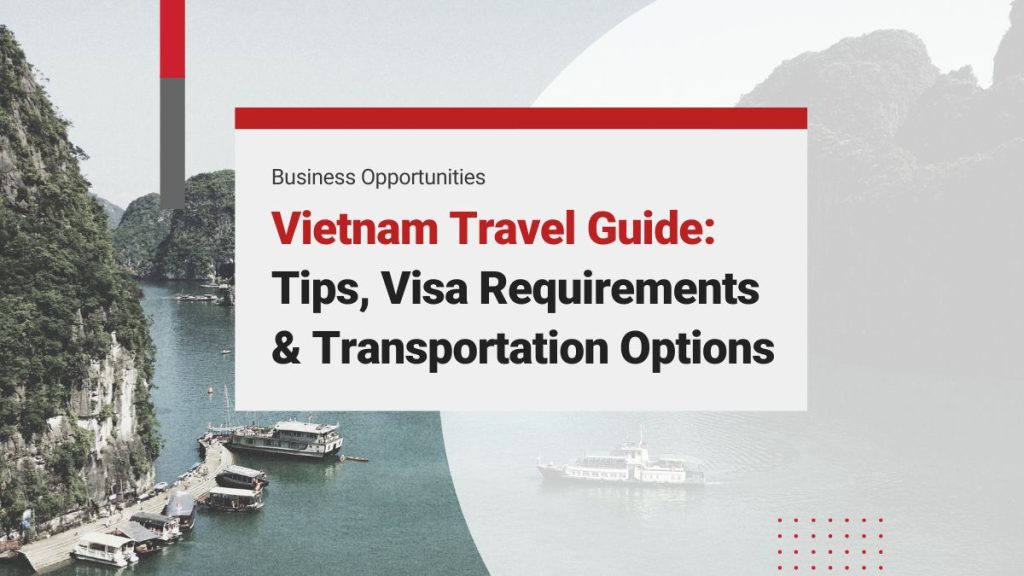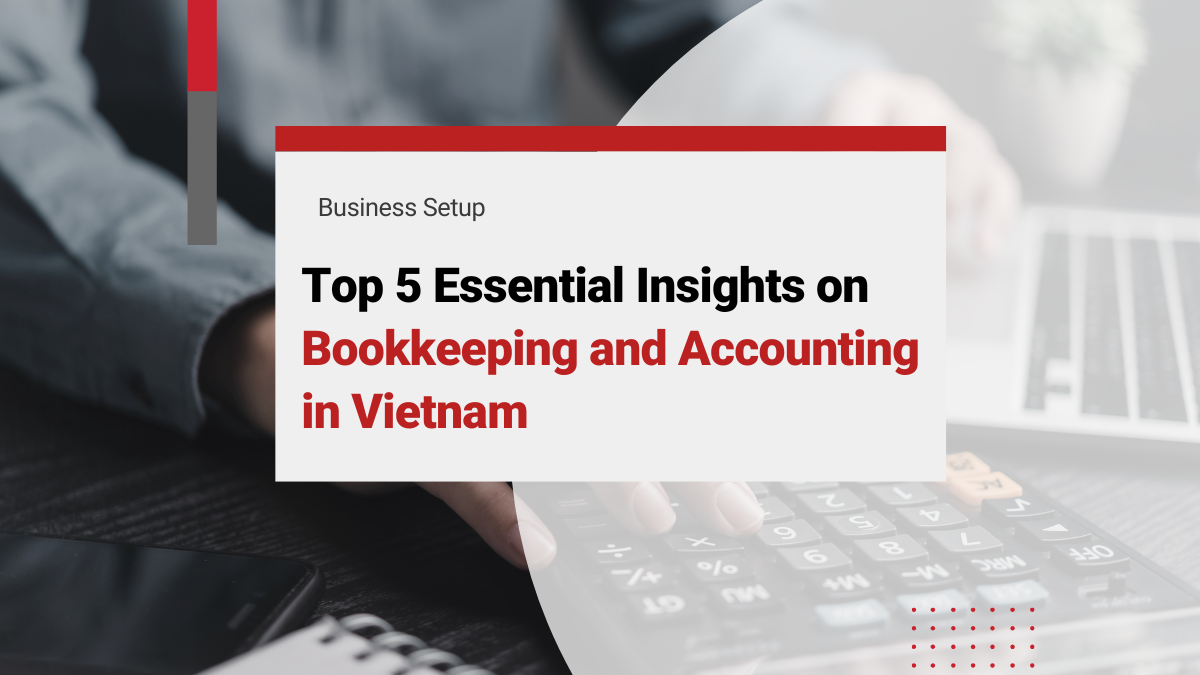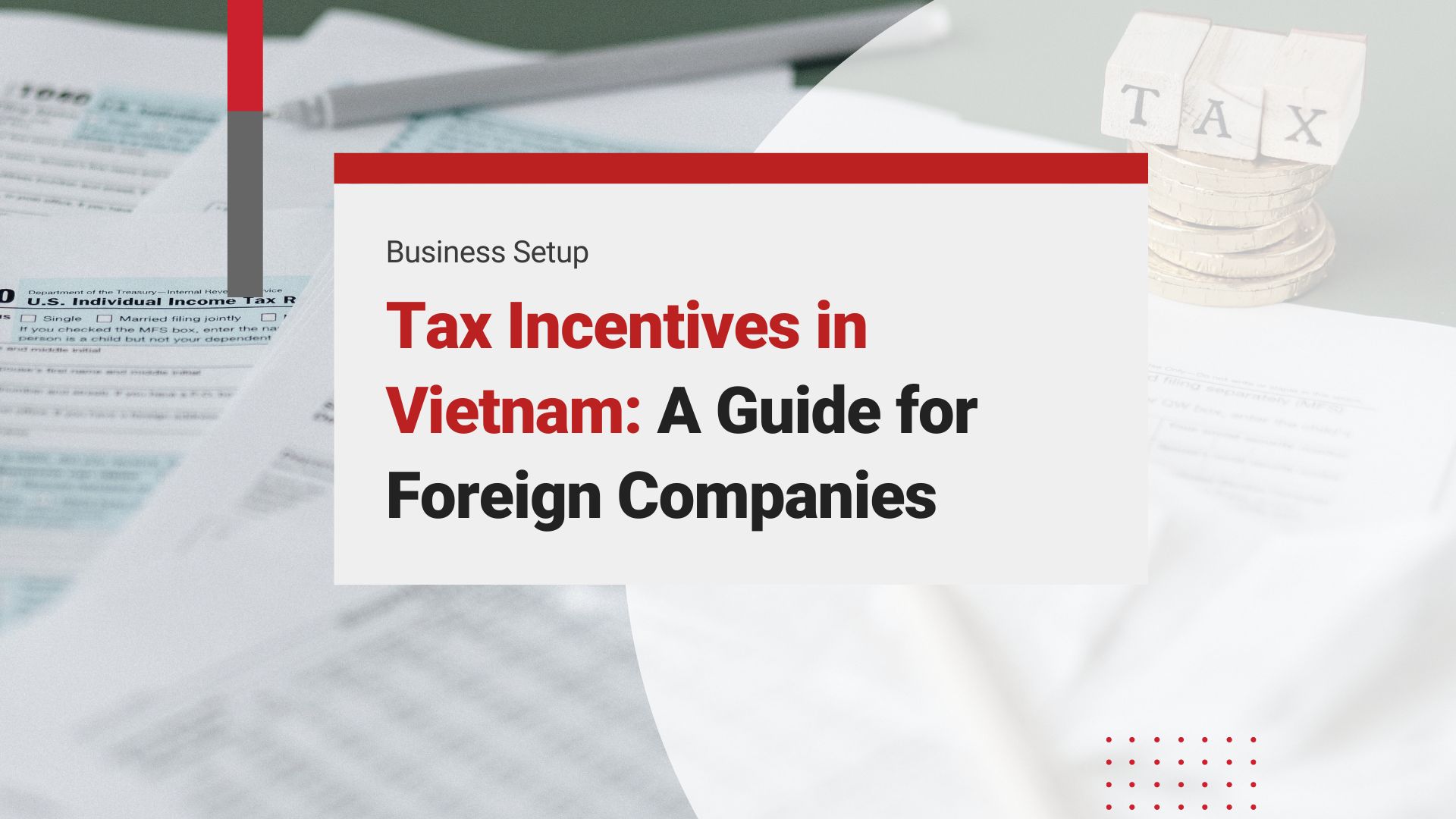Are you considering a trip to Vietnam? If not, now is the perfect time to incorporate this Southeast Asian treasure into your travel itinerary. The allure of Vietnam’s breathtaking vistas and deep-rooted cultural heritage makes it an unmissable destination. Vietnam’s breathtaking beauty is showcased through its myriad of tourist hotspots. From the majestic limestone formations of Ha Long Bay to the charming old town architecture of Hoi An, this country offers diverse experiences.
In this article, we provide you with a comprehensive guide covering the best places to travel in Vietnam. It will also include practical details like tourist visas and various transportation options, to help you easily navigate the country.
Need help with a Visa in Vietnam? Check out InCorp Vietnam’s Immigration Services now
Some Best Destinations for Travelers
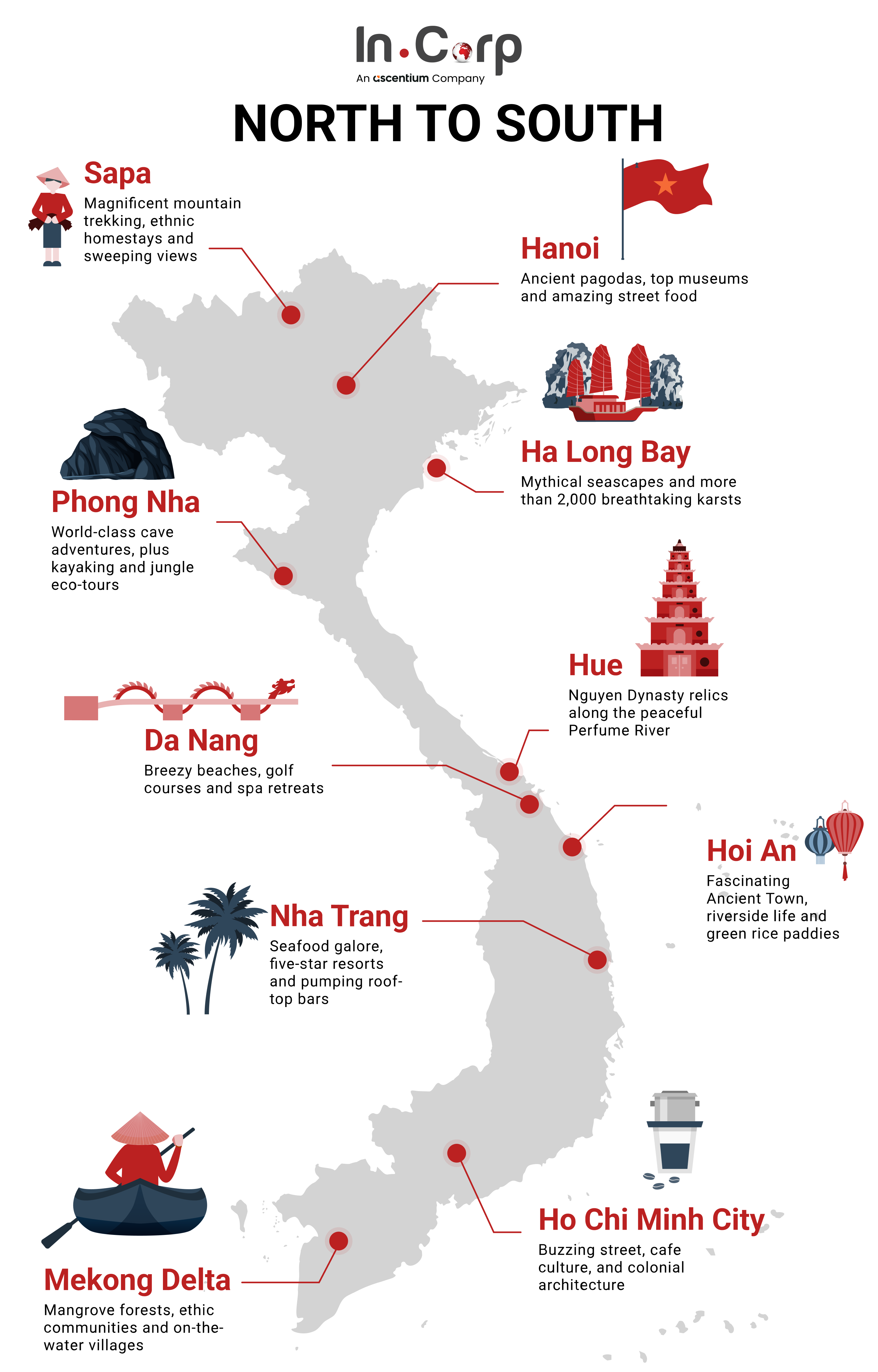
Vietnam is brimming with destinations waiting to be discovered, and this travel guide showcases some of the most sought-after ones. We have divided the country into three distinct parts to simplify your exploration.
Northern Vietnam
Here are the top destinations you should take advantage of in Northern Vietnam.
Hanoi
It serves as the vibrant capital of Vietnam, where you can wander through the enchanting Old Quarter, savour exquisite street cuisine, and discover renowned landmarks such as Hoan Kiem Lake and the Temple of Literature.
In Hanoi, the best times to visit are typically from April to June or from September to December. During these periods, visitors can enjoy hot days with clear skies or cooler temperatures with sunny weather. However, June sees soaring temperatures and high humidity, while December to March brings misty and atmospheric conditions.
Read More: Hanoi Business Incorporation Guide: Opportunities, Requirements, and How-To Steps
Sapa
It is renowned for its picturesque terraced rice fields and vibrant ethnic minority hill tribes. Travellers visit this city to trek through awe-inspiring landscapes and immerse themselves in the distinct culture of local communities. They also come to behold the magnificence of Fansipan Mountain, hailed as the “Roof of Indochina”. Known for its cooler climate, Sapa experiences chilly weather from December to March, occasionally accompanied by snowfall. Late April and early October are ideal times to visit Sapa.
Halong Bay
Recognised as a UNESCO World Heritage site for its breathtaking natural beauty, this destination invites travellers to cruise along its emerald waters. Along the way, you can witness the beautiful charm of limestone karsts, hidden caves, and floating fishing villages.
April to June and September to November offer more favourable weather for visiting Halong Bay, with clear skies and pleasant temperatures. However, tropical storms can occur during other times of the year, sometimes leading to cruise cancellations.
Central Vietnam
Below is a list of the top must-visit destinations in Central Vietnam.
Phong Nha
It is a haven for nature and adventure enthusiasts alike. This UNESCO World Heritage Site boasts magnificent caves, including the world’s largest cave, Son Doong. For an unforgettable experience, you can explore stunning underground wonders here, trek through the lush jungle of the national park, and kayak along the Son River.
Hue
It is the former imperial capital of Vietnam that beckons with its historical significance and majestic citadel. Here, you can explore its UNESCO World Heritage sites, such as the Imperial City and royal tombs, and immerse yourself in the city’s rich cultural heritage, traditional music, and delectable royal cuisine.
Hue has a late rainy season from September to February, with cool and wet conditions. March to August offers warmer temperatures and sunny skies, perfect for exploring the city.
City of Danang
It is a coastal gem in central Vietnam that captivates visitors with its beautiful sandy beaches, iconic bridges, and contemporary skyline. You must include this city in your travel itinerary to experience the allure of its pristine shores. Discover iconic landmarks like the Marble Mountains and the Dragon Bridge, and savour mouthwatering seafood delicacies for an unforgettable getaway.
Hoi An
It is the city that casts a spell on visitors with its impeccably preserved historic architecture and lively riverside ambience. For an unforgettable experience, make sure you wander through its alleys and indulge in tailored clothing shopping. Besides, do not miss joining in the vibrant lantern festival.
From September to January, Hoi An experiences rainy and cool weather, while February to August sees warm temperatures and clear skies.
Nha Trang
It is a coastal paradise that beckons with its crystal-clear waters, pristine sandy beaches, and thriving underwater ecosystems. Visitors flock to this resort city to unwind on its picturesque shores and partake in water sports. They also enjoy island-hopping adventures and immerse themselves in its vibrant nightlife and delectable seafood dining scene. Nha Trang enjoys mostly sunny days throughout the year, with sporadic rainfall from September to December.
Read Related: Vietnam Business Location Guide: Start Smart
Southern Vietnam
When exploring southern Vietnam, there are two cities you absolutely must not miss. These are as follows:
Ho Chi Minh City
The city is a harmonious fusion of contemporary advancements and historical significance. Iconic sites like the Independence Palace and Notre Dame Cathedral, along with the dynamic street food culture, lively nightlife, and profound cultural legacy, beckon visitors to discover their charms.
Read More: 9 Reasons to Launch Your Business in HCMC, Vietnam
Mekong Delta
In this vast maze of rivers, canals, and lush green fields, travellers encounter a unique region often hailed as the “Rice Bowl” of Vietnam. Adventurers venture here to navigate waterways, experience lively floating markets, immerse themselves in traditional village life, and relish the flavours of fresh tropical fruits and local delicacies.
Weather and Climate in Vietnam
The best time to visit Vietnam depends on your chosen destination and the type of experience you want to seek. Northern Vietnam boasts diverse weather patterns throughout the year, with cool to cold temperatures and misty conditions prevailing from December to March.
On the other hand, southern Vietnam has a rainy season from July to September, making December and January ideal months to visit. May to November brings sporadic rainfall and hot, humid conditions, while December to April offers clear skies and sunny weather.
Read Related: How to Succeed in Business Culture in Vietnam: Negotiation and Gifts Giving
Visa Requirements for Foreigners
Before embarking on a journey to Vietnam, verifying the visa requirements tailored to your country is crucial. The e-visa is the favourite choice for most travellers, accessible through the country’s official immigration portal. This process, priced at US$25, usually takes 3 to 4 business days and permits a 30-day visit duration.
Documents Required for a Vietnam Visitor Visa (Tourist Visa) in 2024
Below is the list of mandatory documents that you must keep handy to get your tourist visa.
- Passport (with at least 6 months validity) following your arrival date and have at least 2 blank pages for immigration stamps. A temporary passport may not be accepted.
- Visa Approval Letter: It is required to get a Vietnam business visa.
- Photo: 2 passport-sized photos (4×6 cm) and must be taken recently without glass-wear.
- Visa Application Form: Immigration Entry and Exit Application Form for Vietnam visa on arrival.
Vietnam Visa Exemption
From August 15, 2023, Vietnam has expanded the period of visa exemption to 45 days, a significant increase from the earlier 15-day limit. This updated policy benefits travellers from 13 countries, regardless of the type of passport or the purpose of their visit. The nations included in this extension are Spain, Italy, Germany, France, the UK, Russia, Japan, South Korea, Denmark, Norway, Sweden, Finland, and Belarus.
Furthermore, Vietnam grants visa exemptions to citizens from 25 countries, enhancing ease of travel for international visitors. These countries are Malaysia, Singapore, Thailand, Indonesia, Philippines, Cambodia, Laos, Myanmar, Brunei, Japan, South Korea, Kazakhstan, Kyrgyzstan, Russia, Chile, Panama, Sweden, Norway, Finland, Denmark, Germany, France, Italy, Spain, and the UK.
Vietnam E-Visa
Starting from 15 August 2023, this country now offers e-visas to citizens of all countries and territories. These e-visas allow for a generous 90-day stay duration and are valid for multiple entries, making travel more convenient and accessible for international visitors.
The following are the designated border gates in Vietnam that allow foreigners to enter and exit using an E-visa:

Download the full guide to E-Visa Regulations for Foreigners in Vietnam here!
How to Do a Vietnam Visa Application Online?
The visa application process for this country is entirely online and straightforward. Opting for a visa on arrival is recommended, as it allows for easy and convenient visa collection at all Vietnamese international airports.
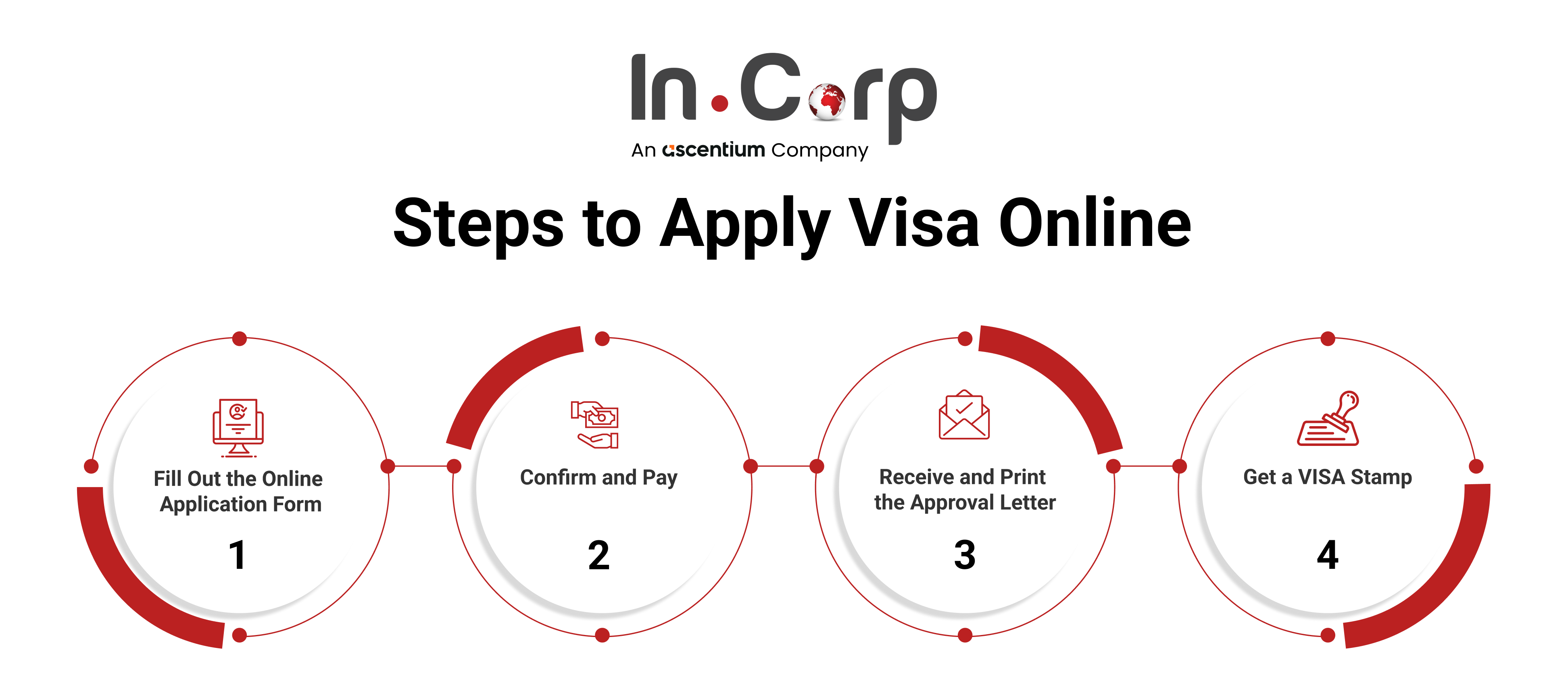
You just have to follow these four simple steps to apply for your Visa online:
Step 1: Fill Out the Online Application Form
This step is important to obtain an approval letter, which is required upon arrival to receive your visa stamp. So, provide accurate information, including your name, passport number, date of birth, nationality, gender, and arrival date.
Step 2: Confirm and Pay
Vietnam visa fees are reasonable, with an online payment ranging from US$17 to US$50, depending on the visa type and quantity requested. Upon arrival, you must pay a stamping fee of US$25 for a single-entry visa or US$50 for multiple entries.
Step 3: Receive and Print the Approval Letter
Your visa request will be processed upon submitting your application and payment. Expect to receive your approval letter via email within 2 business days of submitting your online application. Print the letter, preferably in colour, and keep it with your passport for easy access at the airport in Vietnam.
Step 4: Get a VISA Stamp
Upon arrival at the airport, travellers must complete an Entry/Exit form. It can be obtained at the airports or downloaded from our website in advance. Present your approval letter, passport, photos, and cash payment for the stamping fee to receive the visa stamp in your passport.
Best Ways to Travel in Vietnam in 2 Weeks
Here are remarkable activities to include in your 2 weeks Vietnam itinerary.
Embrace the captivating blend of past and present in historic Hanoi, the vibrant capital that seamlessly merges old Vietnam’s imperial legacy with the modern nation’s dynamic energy. You can also enjoy the atmospheric streets, where you can spend your days exploring wartime relics and imperial monuments. In the evenings, indulge in the culinary delights of Asia’s finest cuisine and refresh yourself with glasses of bia hoi to beat the summer heat.
For a unique experience away from the crowds of Halong Bay, seek out your island paradise in the serene beauty of Bai Tu Long Bay and Lan Ha Bay. While Halong Bay may be well-discovered, hidden gems are still waiting to be explored. Escape the tourist masses by kayaking through Lan Ha Bay’s picturesque landscapes, where sculpted rock formations rise from the emerald waters like the teeth of sea monsters.
Alternatively, unwind in the tranquillity of Bai Tu Long Bay, where jungle-capped islands frame secluded resorts and tranquil beaches, offering a peaceful retreat from the hustle and bustle of urban life. Whether you are exploring historic streets or seeking serenity amidst natural beauty, Vietnam offers an unforgettable adventure waiting to be discovered.
Transportation in Vietnam
Vietnam offers many options for travelling long and short distances, ensuring travellers can explore the country comfortably and affordably.
Domestic flights are an excellent choice for long distances, providing convenience and cost-effectiveness. Vietnam boasts three major airlines: Vietnam Airlines, Vietjet Air, and Bamboo Airways. Collectively, they serve around 21 domestic airports, making it easy to traverse the nation swiftly.
Alternatively, bus travel presents a popular and extensive network connecting every corner of this country. It is known for its affordability and various options, from day buses to sleeper buses, accommodating different preferences and budgets.
Train travel offers a unique experience of soaking in the country’s scenic beauty at a leisurely pace. The Reunification Express between Hanoi and Ho Chi Minh City offers a picturesque journey with stops at key destinations along the coast. Travellers can choose the level of comfort and affordability that suits their preferences, ensuring a memorable and enjoyable journey.
Taxis, on the other hand, offer affordable door-to-door service, with apps like Grab facilitating easy booking and communication.
While walking in urban areas can be challenging due to poor sidewalks and traffic, trekking opportunities outside cities allow exploration of Vietnam’s diverse landscapes. Additionally, cycling provides a fantastic way to immerse oneself in the peaceful countryside and explore local towns, with bicycle rentals readily available at nominal prices.
Boats and cruises are popular for discovering the rivers, canals, and breathtaking landscapes of destinations like the Mekong Delta and Halong Bay.
Some Policies and Procedures to Note
International travel agencies are entitled to seek approval from the Vietnam Immigration Department (VID) for tourist entry, exit, or transit, as outlined in Article 13 of Decree No. 92/2007/ND-CP. This decree elaborates on enforcing various provisions of the Tourism Laws, encompassing regulations concerning the rights and responsibilities of international travel agencies.
Consequently, international travel agencies have the legal authority to solicit assistance from the VID in obtaining visa Approval Letters for their tourist clientele.
Article 13. Rights and Obligations of International Travel Enterprises
1. An international travel enterprise possesses the following rights:
a) Enjoying business autonomy and assuming responsibility for tourism business activities;
b) Requesting a competent state agency to approve the entry, exit, or transit of tourists;
c) Having their lawful tourism business activities protected by the State;
d) Participating in tourism promotion activities and joining professional associations;
e) Exercising other rights provided for by law
2. An international travel enterprise is obligated to:
a) Establish, register, and conduct its business in compliance with the law;
b) Employ tourist guides holding international tourist guide’s cards to accompany foreign tourists and adhere to labour regulations regarding employment;
c) Inform the provincial-level state agency responsible for tourism of any change in its travel business administrator within 30 days of such replacement;
d) Monitor and maintain accurate statistics on the number of tourists to whom it has provided tourism services;
e) Ensure the conditions for and interests of tourists as per the agreements reached;
f) Fulfill any other obligations stipulated by law.
National Ordinance No. 24/2000/PL-UBTVQH10
Regarding foreigners’ entry, exit, and residence in Vietnam, the Standing Committee of the Vietnam National Assembly enacted National Ordinance No. 24/2000/PL-UBTVQH10 on April 28, 2000. This ordinance comprises seven chapters and 26 articles, delineating the responsibilities of various entities in Vietnam visa issuance and specifying eligibility criteria for obtaining visas to enter Vietnam and the permitted duration of stay.

clients worldwide

professional staff

incorporated entities in 10 years

compliance transactions yearly
Learn the Right Setup for Business
Expansion in the Vietnam
Frequently Asked Questions
Can I Travel To Vietnam
- Yes, you can travel to Vietnam, but entry requirements depend on your nationality and current travel regulations. Check visa requirements and any COVID-19-related restrictions before planning your trip.
Can U.s. Citizens Travel To Vietnam Right Now
- Yes, U.S. citizens can currently travel to Vietnam. A valid passport and a visa or pre-approval for a visa on arrival are required. Entry requirements may change, so it's best to check with the Vietnamese embassy or consulate before traveling.
Can You Get Visa On Arrival Vietnam
- Yes, Vietnam offers visa on arrival for citizens of certain countries, but it requires pre-approval from a travel agency before arrival. This option is only available at select international airports.
Do Canadians Need Visa To Vietnam
- Yes, Canadian citizens need a visa to enter Vietnam. They can apply for an e-visa online or obtain a visa through a Vietnamese embassy or consulate.
